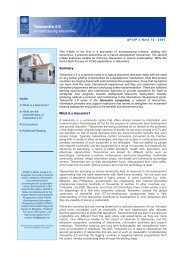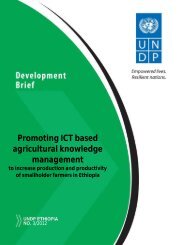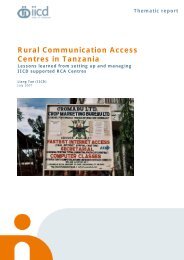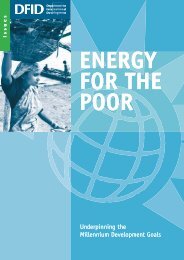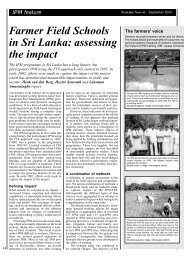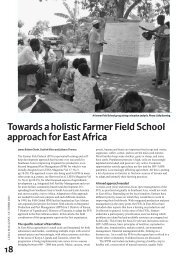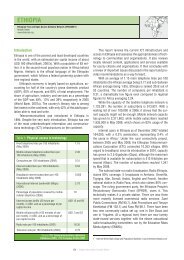School Networking Initiatives and School- Based ... - Share4Dev.info
School Networking Initiatives and School- Based ... - Share4Dev.info
School Networking Initiatives and School- Based ... - Share4Dev.info
You also want an ePaper? Increase the reach of your titles
YUMPU automatically turns print PDFs into web optimized ePapers that Google loves.
Within the last two years, a computer laboratory was built for every one of the CJSSs <strong>and</strong> Senior<br />
Secondary schools. Currently, all Senior Secondary <strong>and</strong> 51 of the CJSSs have been provided with<br />
computer hardware <strong>and</strong> software. Each of these lab includes twenty computers, server <strong>and</strong> local<br />
area network.<br />
Impressively, the government is also underwriting the Internet connectivity <strong>and</strong> national technical<br />
support for all these labs. There are at least two government-supported national vendor contracts<br />
which provide technical troubleshooting <strong>and</strong> maintenance to all the schools. As the remaining 154<br />
CJSSs are equipped <strong>and</strong> connected to the Internet, there are legitimate concerns being raised<br />
about the sustainability of continuing this same level of government-sponsored support. 10<br />
<strong>School</strong>Net-Nigeria<br />
While <strong>School</strong>Net-Nigeria operates as an independent NGO in that country, much of its financial<br />
<strong>and</strong> operational support comes from the Nigerian Education Tax Fund, a source of revenue<br />
derived from a 2% profit tax levied on all major businesses operating in that country. Working in<br />
t<strong>and</strong>em, representatives from ETF <strong>and</strong> <strong>School</strong>Net-Nigeria are planning an ambitious schoolnet<br />
which will initially include thirty-five schools, seven of these in community centers for teacher<br />
development <strong>and</strong> twenty-eight in secondary schools. A number of these sites will be connected to<br />
the Internet VSAT satellite connectivity.<br />
[I will add a section about <strong>School</strong>Net initiatives in Latin America, specifically the Enlaces-Chile<br />
program.]<br />
Section II: About Telecenters<br />
Existing educational institutions hosting community telecenters can form an important part of a<br />
regional or national <strong>School</strong>Net initiative by helping to sustain the local institutional costs of ICT<br />
training <strong>and</strong> service provision. The community telecenter model was initially adopted in<br />
industrialized countries such as Canada <strong>and</strong> Australia to extend ICT services <strong>and</strong> training to<br />
under-served <strong>and</strong> rural populations. In the mid-90s, the model was adopted by a variety of<br />
international stakeholders, including Canada’s International Development Research Council<br />
(IDRC), International Telecommunications Union, Education Development Center <strong>and</strong><br />
UNESCO, for use in developing countries.<br />
As there are a variety of different models, a general definition for a “telecenter” is a community<br />
facility that provides integrated Information <strong>and</strong> Communications Technology (ICT) services<br />
such as Internet, printing, fax, computer access, printing <strong>and</strong> phone facilities. The difference<br />
between a “cybercafe” <strong>and</strong> community “telecenter” is the latter serves a community development<br />
mission, typically serving under-served <strong>and</strong> rural communities, while the former is principally<br />
driven by a mission of profit generation.<br />
While there has been considerable international <strong>and</strong> national interest in community telecenter<br />
development <strong>and</strong> several notable publications about their impact – both actual <strong>and</strong> potential, 11 the<br />
majority of st<strong>and</strong>alone community-driven telecenter initiatives are simply not financially selfsustaining.<br />
Those that are deemed most successful have benefited from considerable external<br />
donor support. An author of one telecenter evaluation report notes:<br />
10 Bloome, Anthony, Botswana-World Links for Development Programme Proposal, December 1999<br />
11 www.idrc.ca/telecentre<br />
8



